Vol 5 No. 8 TROPIC LIGHTNING NEWS February 23, 1970
Index
| Unit Page | Unit Page | Unit Page | Unit Page |
| 1/5 6 | 2/12 Photo 3 | 2/27 3 | 3/4 Cav 1 |
| 1/5 Photo 6 | 2/12 3 | 212 MP Photos 4 | 3/4 Cav 3 |
| 1/5 8 | 2/14 1 | 212 MP 4 | 3/22 1 |
| 1/5 8 | 2/14 Photo 1 | 212 MP Photos 4 | 34th Armor 3 |
| 1/27 Photo 1 | 2/22 1 | 3d Bde LOH 8 | 44th Scout Dog 1 |
| 1/27 8 | 2/22 3 | 3d Bde 8 | 75th Inf 7 |
| 2nd Bde 6 | 2/27 3 | 3d Bde 8 | 75th Inf Photos 7 |
Bushmaster
Hard Job for Dragons Proves Harder for Enemy
BY SP4 GREG STANMAR
CU CHI - Building a new campsite every night, pulling night ambush
patrols and then coming back for daylight sweeps wasn't easy for Bravo Company
2d Battalion, 14th Infantry. But then, it was a lot harder on the eight
dead enemy the Dragons tallied up.
The four-day bushmaster operation began with a sweep through the
Filhol Plantation. The Dragons were working with a company from the 2d
Battalion, 22d Infantry (Mech). The tracks provided transportation into
what was thought to be a recent holding area for a battalion of NVA.
After setting up a night perimeter surrounded with numerous APs,
the enemy made his presence known. The first platoon still moving into
their night ambush position, did not prove courteous guests.
"We opened up with M-16 fire and machine guns," said Sergeant
James Northington, platoon sergeant. "We got the first one and spotted
another heading for his bunker home. He didn't make it."
On the third night of the operation Private First Class Mike
Vallentine, Hornell, N.Y., "spotted this VC. He looked lost. I was
walking point and so got the first shot at him."
A 6.5 mm pistol, a personal radio, a GI compass and a small amount
of money were found on the body.
The final day of the operation did not bring a slowdown of action.
While giving the area a final sweep, more empty cans and fresh fires were
spotted.
"We saw these three NVA waiting for somebody," said Private
First Class Johnny Scott, Seminole, Tex. "We got the one up front right
away. The other two were about 100 meters away. But we got them with
no sweat."
In addition, Lieutenant Colonel Donald Crutchley, Dragon commander,
shot one NVA while he was airborne in his Command and Control ship.
On the eve of the action-packed bushmaster, the third platoon of
Bravo killed two NVA on an ambush patrol.
The eight dead, by actual count, for the week caused one GI, newly
arrived on line, to comment, "so this is the way it is. It makes me
wonder what's going to happen in my next 49 weeks."
Evacuate Headquarters
Regulars Uncover Regiment
By SGT K. C. CULLEN
TAY NINH - A regimental size base camp is nothing new to the
Regulars of the 3d Battalion, 22d Infantry but when it is less than a week old
and stripped bare of anything of importance then it is unusual and suggests the
enemy can't be far away.
A light observation helicopter (LOH) received ground fire from the
region of the saddle due north of Tay Ninh, and Bravo Company of the Regulars
reacted quickly via heliborne assault.
They were on the ground for only a short time when they began to
take fire from a nearby woodline. Under the cover of organic weapons,
Bravo pulled back and let the artillery and air pound the area thoroughly.
Charlie Company soon joined Bravo on the ground and Alfa was
inserted on the other side of the finger of jungle to operate as a mobile
blocking force.
As the two companies moved into the woods, they continued to
receive sporadic sniper fire and they were soon in the midst of an enemy
regimental headquarters and staging complex.
The main body had withdrawn to the north, deeper into the jungle
but the harassing snipers remained as the Regulars moved through the bunkers.
The enemy had taken most of their g e a r, but assorted mortar, RPGs and small
arms ammo, along with food, cooking utensils and medical supplies were found in
fresh, large bunkers with as much as five feet of overhead cover.
Alfa Company was left behind when the other companies were
airlifted out. For three days, Alfa played cat and mouse with the snipers
having cut them off from the main group. The Regulars once returned to a
previous night location to find enemy troops scavenging through destroyed 155
canisters which had been used to bring in water. Three enemy were killed
and another caught by the alert Regular point man. One AK-47 assault rifle
was captured.
The Communists once again had tried to set up a base near the
heavily populated villages to the north of Tay Ninh City and again the Regulars
thwarted their effort and drove them deep into the jungle.
| THE SIMPLE PLEASURES - During a lull, SP4 Will Fazenbaker of Monroeville, Ohio, working with Alfa Company, 1/27th, near the Vam Co Dong river, lazes on a hammock at the Sugar Mill. (Photo by SP4 Frank Rezzonico) | 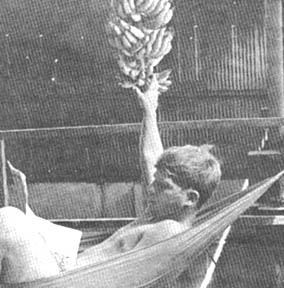 |
Slithery Strangers Shake Sandbaggers
By SP4 BRAD YAEGER
CU CHI - There were screams and flying shovels and Vietnamese
sandbag girls scattering pell mell when they found another "hooded stranger"
in their midst.
At the 44th Scout Dog Platoon in Cu Chi where a small
reconstruction project was under way, men of the platoon were using ammo boxes
to make new sidewalks.
"We were ripping out the old rotted sidewalks when it
happened," said Specialist 4 Willie Posey of Haines City, Fla.
"I heard the sandbag girls scream and I turned to find a
four-foot Indian Cobra sliding out from beneath the walk."
In the titanic struggle that ensued, Posey was able to subdue the
Cobra with a long handled shovel. After the discovery of the first snake,
the men figured that where there was one, there were bound to be many.
"The snakes were packed under there like sardines," said
Sergeant Frank Smith of Holyoke, Mass., platoon sergeant for the 44th Scout
Dogs.
"In the next 100 feet of walk we ripped out, we found one more
Cobra, a krait, a bamboo viper, one unidentified snake and one dead rat.
"One of the guys even found a snake in his hootch, up in the
rafters," he said. "Needless to say, we don't do too much walking
around here in shower shoes anymore," Smith added.
NVA Leads Horsemen To 16 More Prisoners
By SP4 JOE O'ROURKE
FSB WOOD III - The capture of one young North Vietnamese soldier
led the Horsemen of Alfa Troop, 3rd Squadron, 4th Cavalry, to the chain reaction
capture of 17 enemy soldiers recently.
"We were on a reconnaissance in force mission near Fire Support
Base Wood III," said Specialist 4 Harold Alexander, a cavalryman from Atlanta,
"when someone spotted a hole."
A thorough search of the position resulted in the capture of a
young North Vietnamese soldier. Not many of the Horsemen thought they
would get very much important information from such a young boy, but their
assumptions turned out to be wrong. With the help of the troop's Kit
Carson Scout, the boy told them he was 14 years old and had been in the North
Vietnamese Army for two years. He said his father, a Commanding Officer in
an NVA Unit, had threatened to kill him unless he joined the army.
Most importantly the captured NVA told the Horsemen the location of
another enemy hiding place.
Private First Class Carlos Tavarez, a combat medic from West Los
Angeles, said, "We started searching for the other hole the boy told us about
and it was right where he said it would be."
Inside the hiding place were four more North Vietnamese.
After a few minutes of questioning, the four prisoners revealed the location of
still another hiding place containing four more NVA. The same pattern
followed for the rest of the day's operation.
By day's end the Horsemen had found three more enemy-occupied
holes and a grand total of 17 prisoners. Along with the 17 POW's, eight
assault rifles and a Chicom pistol were captured.
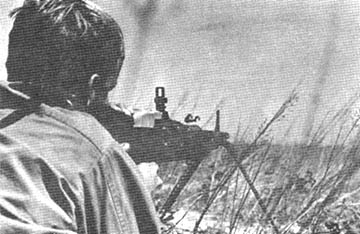 |
WITHERING FIRE - Specialist 4 William Lovelace, Joyer, N.C., a member of the Bravo Company Golden Dragons, 2/14th, fires his M-60 machine gun near a patrol base perimeter. (Photo by PFC Ray Byrne) |
Dreadnaughts Build Range
FSB BUELL - Second Battalion 34th Armor (Dreadnaughts) completed
an M-16 firing range and dedicated it to the allies killed in Vietnam.
The firing and qualification range has been designed for day and
night firing. Upon completion of difficult operations the men of the unit
go to the range to zero their weapons.
The range is the first of its kind to be built at a fire support
base. Former First Brigade commander, Colonel John E. Tyler, officially
fired the first shot down the range to open it.
The dedication sign that hangs at the range reads, "In memory of
those who have made the supreme sacrifice in the fight to preserve and stop the
spread of Communist aggression."
Page 2 TROPIC LIGHTNING NEWS February 23, 1970
Decorated
| BRONZE STAR FOR HEROISM | |
|
LTC Corwin A. Mitchell, HHT 3d Sqdn, 4th Cav |
SGT John L. Schafer, Co C, 3d Bn, 22d Inf |
Tropic Lightning Tots
The Commanding General Welcomes
The Following Tropic Lightning Tots
To The 25th Infantry Division – As
Reported By The American Red Cross.
Born To:
| Feb. 4 SGT Jimmy L. Leonard, Hq. Trp. 3/4 Cav., girl Feb. 6 SGT Byron L. White, 25 TACP (USAF), girl SSG Dennis L. Dixon, 25 MP Co, girl SGT Charles Sanders, E. Co. 2/27, girl SP5 Tommy Watkins, 587 Sig. Co., girl Feb. 7 SP4 Glenn W. Ransier, HHB 1/8 Arty, girl Feb. 9 SP4 Robert J. Lundquist, HHC 1/5, boy |
Feb. 9 1LT Martin Gonzales, C Co. 1/27, boy Feb. 10 SP5 James E. Smith, 372nd R R Co, girl SP5 Charles Dale, D Co. 2/22 Inf., girl 1LT Paul Louis Grube, HHC & Band, girl Feb. 11 SGT David McClennen, Co. C 2/22, Girl Feb. 12 SP4 Eugene Worden, A Batt. 7/9 Arty, boy |
Learning Back in the World
Army Offers Programs to Help Gis Back to School
By SP5 PAT MORRISON
If further education is your bag, "Project MEMO" was designed
for you. MEMO (More Education, More Opportunity) is the program kicked off
by comedian Bob Hope on his Christmas tour. MEMO helps you start arranging
for your education while you're still in the service. It's for
servicemen who haven't completed their first four years of college.
MEMO will get you in touch with a high school superintendent, a
trade school, technical school, business school or college in your home state.
You can name the school or let MEMO submit your name to several. It costs
nothing.
All you need is a "Project MEMO" application form from your
education NCO or from the Education Center. In from two to six weeks, one
or more schools will contact you here in Vietnam.
IF YOU GET IN TOUCH with a school through Project MEMO or on your
own and the school requests entrance examinations, your Education Center has you
covered again. These may be taken at the Education Center. They are
given on certain dates at the same time all over the world. The college
will tell you which test they require for entry. The cost is about six
dollars.
Applications for these entrance exams are available at your
Education Center and should be mailed five weeks prior to your test date.
COLLEGE GRADS who are applying for graduate schools may also take
required entrance examinations at the Education Center.
Applications for the Graduate Record Examination (GRE), the Law
School Admission Test (LSAT) and the Admission Test for Graduate Study in
Business (ATGSB) are available at the Education Center. Here again,
applications must be mailed five weeks prior to the test date.
ENLISTED MEN MAY RECEIVE an early release from the Army to enter or
return to school. Up to 90 days can be chopped off your military hitch by
this method. Although it may take several weeks to gain the necessary
acceptance from the school, Army approval is virtually automatic.
To apply for a school drop you need a letter from a recognized
institution of higher education stating that you are accepted for enrollment for
a specific school term as a fulltime student. The school's letter must
state the latest date on which you must report to the school in person for
registration in order to meet the school's requirement for attendance.
The letter should also note the first day of classes.
A short statement from the serviceman is also needed saying he is
able to pay the school entrance fee, that this school term is the most opportune
time for him to begin or resume his education and that he is aware that giving
false statements to secure a separation from the service may lead to
prosecution.
You will need to write the school yourself for the letter of
acceptance and specifics. Your unit clerk will take care of your personal
statement once you have obtained the acceptance letter from the school.
These two statements along with a short enclosure from your immediate commanding
officer are sent through battalion headquarters to 25th Division Headquarters
for consideration.
The effective date of your separation can be up to 15 days prior to
the first day of classes. The Division Personnel Actions Office would like
your paper work a month or more before your new DEROS.
YOU ARE ELIGIBLE for educational assistance under the GI Bill if
you are discharged or released under other than dishonorable conditions and were
on active duty for a continuous period of 181 days or more.
Effective Dec. 1, 1968, a veteran having 18 months or more active
duty is entitled to 36 months of educational benefits. Veterans returning
to complete high school in no way jeopardize their 36 months of educational
benefits which may be used after earning a high school diploma.
Although the GI Bill does not make provisions for educational
loans, most colleges have loan programs. Write your school for details.
TO GET GI BENEFITS at the time of your separation from the service
you will be given an opportunity to pick up a VA Form 21E-1990. These are
also available at your local Veterans Administration Office and from any college
registrar.
Submit this completed application, along with a copy of your DD-214
(Report of Separation from the Armed Services), and, if applicable, all
documents to support evidence of dependency to the Veterans Administration
Office serving the area in which you reside.
The VA will issue two copies of the Certificate of Eligibility
which you submit to the college at the time of registration. Payments are
made directly to you. Your first check will come about five weeks after
you enter school and once a month thereafter for each month you are in school
for up to 36 months.
If you have any questions concerning your education plans, you may
call the Education Center in Cu Chi (5143) or write: Army Education Center 25th
Infantry Division, APO 96225.
Reup: Pays $643 Plus Side Benefits
Recently a PFC who had been in Vietnam 4 months and in the Army 8
months earned promotion to Specialist 4, $643 tax free, a 30-day leave in the
U.S. and a 3-day in-country R & R - all for one action.
He reenlisted in the Army for what amounted to eight months.
Besides all this, his MOS was changed and he began on-the-job training for work
he had wanted to do even as a civilian.
"This isn't an unusual case at all," Captain Denis J.
Tappella, Division re-enlistment officer said. "Any man with eight
months or more in the Army and with at least six months remaining in Vietnam can
get exactly the same thing."
Tappella stressed that this man had originally enlisted for three
years and that by reenlisting after 8 months, he extended his tour of duty to
only three years and eight months. After he came into the Army he had
decided he wanted to work in another MOS. By reenlisting he guaranteed
himself the change of MOS for the rest or his tour.
"They definitely are guaranteed the change of MOS if they request
it when they re-enlist," said Tappella. "And they are guaranteed the
side benefits as well."
Tappella said that men who have been in the service more than 21
months could earn up to $10,000 with a variable reenlistment bonus when they
reenlist.
The Division provides lots of places to re-enlist, Tappella said.
Each battalion maintains a re-enlistment office, a re-enlistment office is
located across the street from Wakiki East in Cu Chi (standdown area), and a
re-enlistment office is located next to 1st Brigade Headquarters in Tay Ninh.
"We think reenlistment benefits give the best deals the Army has
to offer," Tappella said. "A man can change his job, get a vacation
and get paid for all of it."
|
Benefits of GI Bill The GI Bill grants you a monthly allowance to help you meet the
cost of living, tuition, fees, books and supplies. The rates of monthly
pay are as follows: |
||||||||||||||||||||
|
||||||||||||||||||||
|
||||||||||||||||||||
|
The TROPIC LIGHTNING NEWS is an authorized publication of the 25th Infantry Division. It is published weekly for all division units in the Republic of Vietnam by the Information Office, 25th Infantry Division, APO San Francisco 96225. Army News Features, Army Photo Features, Armed Forces Press Service and Armed Forces News Bureau material are used. Views and opinions expressed are not necessarily those of the Department of the Army. Printed in Tokyo, Japan, by Pacific Stars and Stripes.
MG Harris W. Hollis . . . . . . . Commanding General
MAJ Warren J. Field . . . . . . . Information Officer
1LT John Caspari . . . . . . . . . Officer-in-Charge
SGT John Genitti . . . . . . . . . . Editor
SP4 Charles C. Self . . . . . . . . Assistant Editor
SP4 Gary D. Sciortino . . . . . . Assistant Editor
SSG Jack Anderson . . . . . . . Production Supervisor
BATTALION CORRESPONDENTS
| SP4 Dennis Bries SGT Bill Oberholzer SP4 Jim Williams SGT Wally Baker SP4 Greg Stanmar SP4 Phil Jackson SP4 Jeff Hinman SP4 Doug Sainsbury SP4 Ken Barron SP4 Greg Duncan SP4 Brad Yaeger SP4 Frank Rezzonico |
2/22 4/23 2/12 2/34 2/14 2/27 2/12 2/77 1/8 2/27 1/27 1/27 |
SP4 Dan Neff SP4 Henry Zukowski SP4 Joe O'Rourke PFC Ray Byrne SGT William E. Zarrett SP4 Robert Caplan SP4 Brian Flaherty SP5 Pat Morrison SP4 Rich Fitzpatrick PFC Rob Lato SP4 Ken Barron SGT William E. Zarrett |
7/11 2/22 3/4 2/14 4/9 4/23 3/22 3/13 1/6 2/27 1/8 4/9 |
Page 3 TROPIC LIGHTNING NEWS February 23, 1970
Up to Charlie's Tricks
'4th Platoon' Chases Enemy
By SP4 JOSEPH L. O'ROURKE
The ability to counteract the enemy's use of darkness as a shield
for concealing his night-time operations has always been a problem to units in
Vietnam. Night activities of the enemy working in the Boi Loi Woods have
been drastically inhibited by the 3rd Squadron, 4th Cavalry's new "4th
Platoon."
The ground units of the Cav have been diversified by reorganizing
and employing the men in each troop to form the new "4th Platoon" dubbed the
"Night Raiders." The 4th Platoon is used specifically for day and
night ambush patrols.
First Lieutenant Thomas J. Morgan, Charlie Troop's 4th Platoon
Leader from Port Arthur, Tex., said, "Since employing the new concept of the
4th Platoon ambush patrol we have been able to curb enemy activity both at night
and during daytime. During the day the troop performs a reconnaissance,
surveying the area and telling us where fresh enemy activity is.
"The 4th Platoon is then inserted. We wait, and it
doesn't take too long before the enemy shows up. We let them have it
with everything we have, check out the bodies quickly, and get out of the area
fast! You might say we are fighting like Charlie because we move in a
small group, hit hard, and move away quickly."
Private First Class Boyd C. Butterfield, a grenadier from Portland
Oregon, who is nicknamed, "Seven-Nine," because of his accuracy with his
M-79 said, "I remember one AP we went on. We stayed in the area where
the troop ate chow. Within 45 minutes two NVA soldiers came walking in
kicking cans and looking for any food the troop might have left laying around.
"We let them have it killing them. Then someone spotted one
in a tree and I used my M-79 which took care of him. Again we spotted one
in a trench and I fired killing him also. When we checked the trench line
we also found blood trails leading away, that indicated we wounded some more."
Lieutenant Colonel Corwin A. Mitchell from Springfield, Va.,
Commanding Officer of 3rd Squadron, 4th Cavalry, originally initiated the idea
of the 4th Platoon ambush patrol, while Captain Oleh B. Koropey, from Pawtucket R.I., took care of training the men.
"The men from each ambush platoon went through intensive training
in the methods that were desired by the Cav," said Major Webb Kremer, Squadron
S-3, from Arlington, Va. "Each man was given training in ambush
techniques, night movement, demolitions, and adjustment of artillery and
gunships.
"One of the direct results of the Cav's ambush patrols since
the end of January has been that none of the Troops have received any enemy
attacks by fire or snipers while in their night laager positions," Kremer
said.
Hounds Hunt Water - New Well At PB Kotrc
By SP4 RICHARD DOMBROWIECKI
CU CHI - "Water, water, everywhere, but not a drop to drink."
This was the problem for both the Ancient Mariner of literary fame
and the men of Patrol Base Kotrc. Kotrc personnel, however, are taking
steps to relieve their problem.
Kotrc has no direct access to fresh water and has had to depend
upon the resupply system for potable water. Unfortunately, only a thousand
gallons can be brought in per day for the men. It must be used for
drinking, cooking, and washing.
Said Captain William H. Schuler Jr., of Ripon, Wis., commander of
Charlie Company, 2d Battalion, 27th Infantry, Wolfhounds, "We would usually be
down to our emergency supply by 4 p.m. every day. And when the choppers
couldn't reach us because of enemy action, we'd really be in a bind."
To ease the situation, Kotrc is taking advantage of what nature has
provided. "The water table in the area is quite high," said the
captain. "Therefore, we are digging a well. It should supply about 1,800
gallons daily so that several chopper flights with water can be eliminated."
Installation of a 600-gallon tank with a filter and purification
unit will complete the operation and hopefully solve Kotrc's watery dilemma.
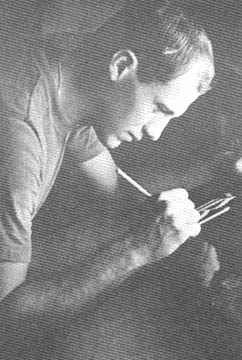 |
WARRIOR DRAFTSMAN - Gothic lettering is one of the specialties of Warrior draftsman Private Ronald Vanone of Haledon, N.J. (Photo by SP4 Jeff Hinman) |
'Zippo's Hideaway' Home Of Drafted Draftsman
By SP4 JIM WILLIAMS
FSB Pershing - Whether it is making a map or chart, lettering a
jeep or just painting a sign, the talented draftsman of the Warriors, 2nd
Battalion, 12th Infantry, will rise to the occasion. That talented
draftsman is Private First Class Ronald Vanone of Haledon, N.J.
Vanone arrived in Vietnam in March last year and spent several
months as a machinegunner with the Warriors of Alfa Company before his talents
were recognized. Warrior Operations finally put "Zippo," as his
friends call him, to work making charts and signs.
It wasn't long before business was booming and Zippo needed an
area set aside especially for him and his operations.
"We started construction of a small shack adjacent to the
Tactical Operations Center at Fire Support Base Pershing back in September,"
said Vanone, "and it was finished in a couple of days."
Inside Zippo built shelves into the wall and constructed a drafting
table. The shack became known as "Zippo's Hideaway."
Before entering the Army, Vanone spent two semesters at Trenton
State College in Trenton, N.J., were he majored in business administration.
"I guess I was born with the artistic talent," said Vanone.
"When I'm given a job to do I just do it the best I can. Someone must
like my work, I guess. I've been swamped with signs to paint and charts
and maps to put together."
Zippo is getting short though, and it will be no easy job for the
Warriors to find a replacement for him.
Sergeant Takes a 2nd Look
Careful Search Pays - in Cache
By SP4 DENNIS J. BRIES
CU CHI — Applying experience learned from two previous tours of
duty in Vietnam, Staff Sergeant Gilbert J. Paris from Owensboro, Ky., led the
men of his platoon to an extremely profitable cache of 50,000 piasters.
Charlie Company, 2d Battalion (Mech) 22nd Infantry, operating as
security for 65th Engineers in a land clearing operation about 10 miles west of
Cu Chi, had captured six VC during the previous day's operations.
Three of them were removed from a tunnel while the others were
captured while trying to escape from the area where the plows were operating.
Numerous documents, a pistol and personal items were also captured.
"The fast moving plows didn't permit us to thoroughly search
the area after we spotted the VC," Paris said.
"It took a little talking to convince the platoon leader and the
company commander that there was more to be found in the area," Paris said.
"I finally got permission to take several men with me and check it over
again."
The next day Paris took eight men with him to the tunnel where the
VC were captured. "Things were pretty messed up but I pointed to a spot
and told them to start digging," Paris said.
Specialist 4 Michael J. Self, St. Louis, said, "At first it
seemed crazy to go back and dig behind the plows but we had only gone down a
foot before we found a new AK rifle."
"We uncovered the money two feet below the rifle," added
Private First Class William R. Drake Jr., Huntington Beach, Calif.
"Where there is one cache there's bound to be another," said
Paris. The VC we captured the previous day were fat, well dressed and
well-to-do. It just bothered me and I had to go back and check again."
Hounds Build Gas Station
By PFC ROB LATO
FIRE SUPPORT BASE JACKSON - "Ready to Strike. . .Anywhere,
Anytime." That is the motto of the 25th Infantry Division. This
motto also holds for the 2d Battalion, 27th Infantry Wolfhounds.
To uphold the lightning reputation of the 2d Hounds, a refueling
station has been added as a time-saving device for helicopters at the battalion
forward, Fire Support Base Jackson.
The refueling pad cuts down on blade hours that were once necessary
to run back to Cu Chi to refuel. Now gunships, slicks or whatever are
flying support for Wolfhound operations simply fly to Jackson, refuel and may return in a matter of minutes instead of hours.
Running the chopper gas station is a three-man team headed by
Sergeant David Brody of New York City and the air service attendants, Private
First Class Charles E. Davis, Washington, D.C., and Specialist 4 Charles Davis,
Tuscaloosa, Ala.
"We will even give the Chinooks a booster so they can complete
their resupply runs to our forward positions near the border," said Brody.
The trio's duties also include daily maintenance of the fuel
pumps and keeping a ready supply of smoke grenades and "60" ammo for
emergencies that might arise, thus saving helicopters the time of returning to
distant rearming points.
"It just goes to show you how busy this refueling pad really
is," said Davis. "Three months ago, we built sandbagged shelters for
the fuel bladders that we had. Since then, we have had to accommodate for
additional bladders, and it looks as though its time for more expansion."
The refueling pad operates between the hours of 7 a.m. and 8 p.m.
"The refueling pad, being a time saver, is a great asset toward the
accomplishment of any mission," commented Captain Hank Jones, 116th Assault
Helicopter Company pilot of St. Louis.
| 50,000 PIASTERS - This money was part of a find uncovered by Charlie Company, 2/22, when Staff Sergeant Gilbert J Paris, Owensboro, Ky, insisted on double checking after a sweep. (Photo by SP4 Dennis J Bries) | 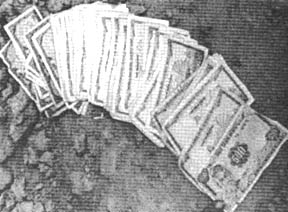 |
Page 4-5 TROPIC LIGHTNING NEWS February 23, 1970
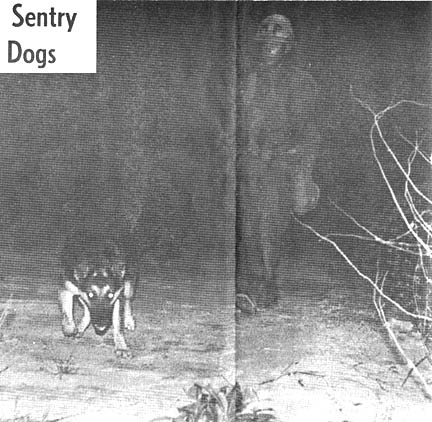 |
|
Story & Photos |
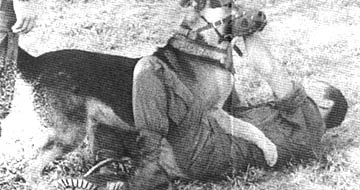 |
|
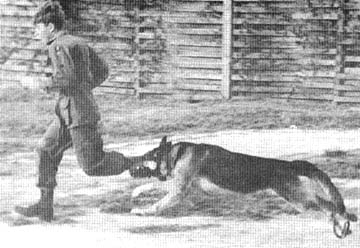 |
There are three types of dogs serving in
Vietnam, Scouts, Trackers and Sentry dogs.
Sentry dogs are trained to attack on command, while Scouts and
Trackers are trained to alert silently on scent or sign so that the men they are
working with can take action. They are warners more than attackers.
"Sentry dogs are trained to pursue, attack and delay an enemy,"
said Staff Sergeant Clyde E. Morgan, who is head NCO of Team B, 1st Platoon,
212th MP Company, (Sentry Dogs), assigned to Tay Ninh base camp for perimeter
patrolling.
"In order to be effective, the handler must be able to control
his dog," said Morgan. "Some dogs will attack anything, anytime, so
the handler has to let him know who's boss.
"The dogs can sense fear. If you are acting afraid, they
will attack, particularly if you run."
Specialist 4 John T. Lettuce Alexandria Va., is handler for a
five-year-old dog named Shadow, who is on his third tour in Vietnam. "The dog knows what to do," said Lettuce, "but he has to get used to the
handler or he won't obey. The dog will try to go his own way with a new
handler until the handler proves he can control the dog. Basically, the
dog wants to cooperate. The handler has to win the confidence of the dog.
Then they are a team."
Veterinarian for the team is Specialist 4 Percy E. Hicks, Bronx,
N.Y., who feeds each dog one can of horsemeat and a two pound size coffee can of
meal, mixed with 12 ounces of water each day.
He treats the dogs for fevers, cuts, bruises and worms, and
maintains a complete medical record on each dog.
"One bad thing here," said Hicks, "is the disease 'I.H.S.'
Most of our dogs have it, and until it is cured the dogs have to stay in
Vietnam. The disease is contagious to other dogs, but not virulently so.
So far no humans have been affected by the disease." I.H.S. is a
blood disease causing even a small wound to bleed without clotting.
Practice and training is part of the Sentry Dog team's daily
schedule. After the sun sets and the air begins to cool, the handlers
bring out their dogs on leashes and begin working with them.
Up through a window and down a ramp and through a length of steel
pipe, the dogs run, stop, leap and obey directional commands as handlers
concentrate on obedience and accuracy of response.
"It is almost impossible to outrun them," says Sergeant Tim J.
Anderson, Hot Springs Ark., who dons a heavy canvas-covered padded cotton suit
for practice. "The dogs are fast - very quick, and good tacklers
also."
In the suit, Anderson stands still while handlers practice
searching and surveillance techniques with their dogs. The dog sits
unmuzzled, watching while the handler searches the "detainee." Any
sudden movement by the "prisoner" brings on a flying rush of dog fangs and
clawing feet.
"I am thankful for the padded suit when that happens," said
Anderson.
After training, the handlers and their dogs mount jeeps for
transport to the perimeter and a night of walking guard along the wire. Tours of
duty are six hours.
In the blackness of the night on the line, the silent partner
tugging on the leash is reassuring to the man walking.
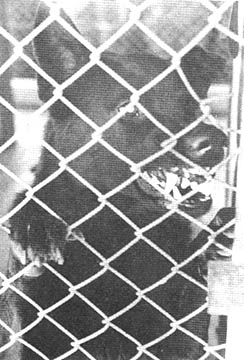 |
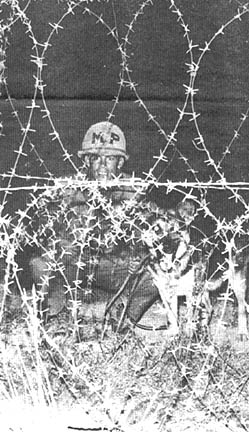 |
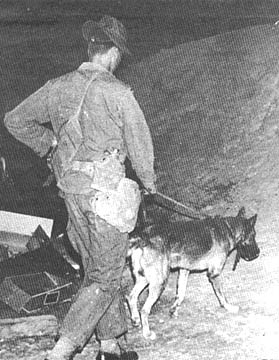 |
Page 6 TROPIC LIGHTNING NEWS February 23, 1970
Homeless Bobcats Move to Dau Tieng
By SP4 RICH FITZPATRICK
FSB DEVIN - Late last month the last elements of the 1st Battalion
(Mech.), 5th Infantry, left Fire Support Base Devin for the last time.
Devin had been the home of the Bobcats for ten months.
The men began a trek across the Filhol, the Boi Loi Woods and the
Ho Bo Woods to their new home in Dau Tieng. The trip would take nearly
three weeks. During this time the battalion would be homeless.
Segments of the battalion criss-crossed their way with from four to
seven night locations. Keeping the men supplied with food, ammo, mail and
other necessities was the job of Bobcat supply.
Feeding two hot meals a day to more than 600 men was a team of six
cooks in the rear who were on call 24 hours a day. Sixty-six mermite cans
of food traveled from Cu Chi to the forward areas and back each day. To
quench the dry throats five 600-gallon water trailers made the daily trip to Cu
Chi to be refilled. For those desiring something more tasty than water
more than 100 cases of soda went to the field daily and were iced down by
sixteen 300-pound blocks of ice.
Laundry, mail and repaired parts also were transported to the men
in the field daily. As replacements completed the Tropic Lightning Re-Inforcement
School, they were taken to their new companies in re-supply choppers.
The enormity of the task of supply of an entire battalion on the
move by air was summed up by Bobcat Mess Sergeant, Sergeant First Class Jack W.
Cassiba of Linden, N.J., who said "I've been in Vietnam four years and have
never seen anything like this."
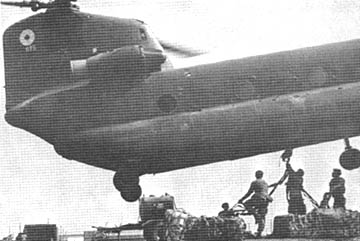 |
UP UP AND AWAY - Fresh supplies begin their daily trip to supply the Bobcats of the 1st Battalion (Mech), 5th infantry, during their move to Dau Tieng. (Photo by SP4 Rich Fitzpatrick) |
Top Soldier Sees How Brigade Works
By PFC RICK CONNELL
CU CHI - Each month for a few fortunate infantrymen of the 2nd
brigade, the war in Vietnam takes a new perspective. These Fire Brigade
GIs are chosen by their battalions as "Soldiers of the Month."
The 2nd Brigade's Soldier of the Month program is designed to
honor the best soldiers of each battalion and to give these top soldiers a
commanding officer's eye view at the operations of the brigade. The
Soldier of the Month is selected by his battalion on the basis of knowledge of
his job, leadership ability, courage and personal character.
Once selected by his battalion, the Soldier of the Month has the
opportunity of spending a day with the 2nd brigade commander, Colonel Ennis C.
Whitehead Jr.
In the morning he is introduced to the brigade commander and spends
some time personally talking with him before attending the morning briefing.
At the morning briefing the Soldier of the Month, along with the brigade staff
officers, is familiarized with the previous day's operations and the
operations that will be carried out for the day.
After the briefing, the Soldier of the Month is photographed with
the brigade commander in front of the commander's Command and Control
aircraft. A copy of the photograph is sent to his next of kin along with a
hometown news release.
DEAR SERGEANT CERTAIN: Shortly before I left the
United States I met a beautiful young lady and immediately fell madly in love.
After a whirlwind romance through the wire at the Overseas Replacement Station
in Oakland I proposed and she accepted. My problem is this: I'm not
interested in getting married by telephone and can't afford an R&R in
Hawaii. How can I bring my finance to Vietnam?
Madly in Love
DEAR MAD: A number of methods have been tried with varying degrees of
success. One loney girl packed herself up in a box addressed to her love
but when the X-rays at the post office were developed she was convinced to stay
with the GIs in San Francisco. Another girl disguised herself as a GI and
climbed aboard a plane bound for Vietnam. It was hijacked to New York.
Of course there are legitimate ways too. She could become a stewardess for
the Bingoi Air Lines which shuttles GIs between the U.S. and Australia.
But after the first night she might not remember your name. If she fails
the stewardess course she might enroll in the extensive two-day training given
donut dollies or apply for a two year course in nursing and a second
lieutenant's commission. But the surest answer is to convince your
Sweetie to enlist as a WAC. After about eight months of training she
should be ready to join you in Vietnam and as she arrives at Bien Hoa you can
wave to her as you board your freedom bird back to the world.
Page 7 TROPIC LIGHTNING NEWS February 23, 1970
Jumping at Tan Son Nhut
Airborne Rangers: Training Hard, Harassing Enemy
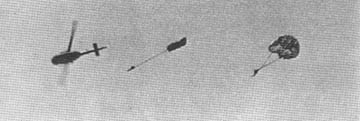 CU CHI - The Airborne Rangers of Company F., 75th Infantry,
perform a Division-wide mission harassing the enemy from the Straight Edge Woods
to the Black Virgin Mountain to the Ho Bo and Boi Loi Woods. Most of the
Ranger operations are performed over two and three day periods by elite
well-trained teams consisting of both U.S. and ARVN Infantrymen.
CU CHI - The Airborne Rangers of Company F., 75th Infantry,
perform a Division-wide mission harassing the enemy from the Straight Edge Woods
to the Black Virgin Mountain to the Ho Bo and Boi Loi Woods. Most of the
Ranger operations are performed over two and three day periods by elite
well-trained teams consisting of both U.S. and ARVN Infantrymen.
Training is a continuous effort for the Rangers and recently they
traveled to Tan Son Nhut Airbase to make parachute jumps. The Rangers
accomplished three things that are important to any Ranger outfit as a result.
First on the list was getting the practice so important to
performing a feat which requires a great deal of skill. Second, the
jumping enables the Rangers to maintain their jump status. Finally, the
Rangers will eventually be awarded Vietnamese jump wings as a result of their
extra efforts.
|
Story and Photos |
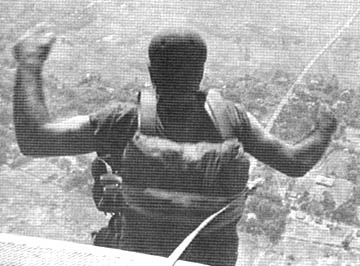 |
The leap into emptiness |
| Teamwork on the ground | 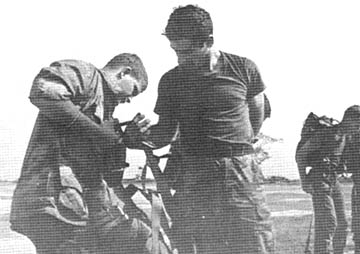 |
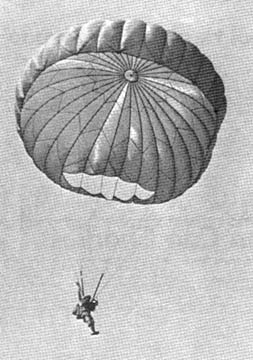 |
Floating Free |
Page 8 TROPIC LIGHTNING NEWS February 23, 1970
Bobcats Grenade NVA in Kill Zone
By SP4 RICH FITZPATRICK
CU CHI - Night after night infantrymen of Charlie Company, 1st
Battalion (Mech.), 5th Infantry had set up their ambushes, but the nights passed
without seeing a single enemy.
Finally, the persistent Bobcats' efforts paid off. After
eight fruitless evenings, the Bobcats engaged an enemy force and killed seven of
the foe.
It was a dark and foggy night with no moon for illumination.
Starlight scopes couldn't be depended upon to spot the enemy. However, a
sharp-eyed Bobcat spotted 15 NVA complete with full field gear and AK-47's.
The NVA were not far off and headed straight for the flank of the Bobcat's
ambush position.
Second Lieutenant James K. Clark of Bardstown, Ky., suddenly found
himself in a difficult situation. Another Bobcat ambush was located 300
meters in the same direction from which the NVA were approaching. The
enemy had already passed the line of friendly claymores and it was impossible to
fire either the M-60 machine gun or M-16's.
There was only one thing to do and Clark did it. He gave the
order to hurl hand grenades at the approaching enemy force. With the best
pitching performance since the New York Mets took the World Series, the Bobcats
fired a series of deadly strikes at the oncoming enemy, dispersing them and
killing seven.
A sweep of the area was conducted following the action. Along
with the seven dead, the Bobcats captured 1/2 pound of documents, 2 AK-47's, 1
K-54 pistol, 50 batteries. Enemy food supplies were also found: 20 pounds
of buffalo meat and I head of fresh lettuce.
Vietnam 1969 Sales Soaring
CU CHI - The 1969 Tropic Lightning Yearbook "Vietnam 1969" has
topped previous years' advance sales records. More than 4,000 orders
have been placed, according to Second Lieutenant Frank DiBella, who is in charge
of sales.
DiBella credits the boom to the "promise of a really fine
book." It will have 220 pages with 80 pages in full color, he said.
"The yearbook covers the life of the 25th Division soldier - the
hard times and the good times, DiBella said. "It tells the story of the
division and its men."
He said Yearbook orders may be placed through Tropic Lightning
Association representatives. The book will have a hard, clothbound cover
and sells for $5 per copy. DiBella added that it may be sent directly to a
subscriber's home address.
A March delivery date is expected.
| HUNTING ENEMY - A Light Observation Helicpoter (LOH) on a Visual Reconnaissance flight mission skims the tree-tops searching for enemy. | 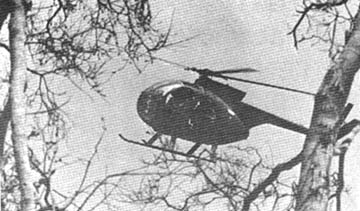 |
Prevent Enemy Buildup
VR Pilots Flush Out Enemy
By SP4 BOB STEPHENS
CU CHI - One of the most effective means of preventing an enemy
buildup near 25th Infantry Division bases is through Visual Reconnaissance (VR)
flights, a pilot flying the missions said recently.
The missions, flown in Light Observation Helicopters (LOHs),
are responsible for spotting enemy elements before they can launch their
operations.
"If the enemy were planning a night attack on Cu Chi Base Camp,
they would have to begin massing their troops outside the wire during the early
evening," said WO1 Kenneth Thiem of Florence, S.C., a pilot with the 3d
Brigade. "We would be able to spot them on the daily VR flight we have
around base camp."
Making visual contact with the enemy isn't easy, he said.
Communist soldiers are masters at camouflage and can hide almost anyplace.
"By hovering low over suspected enemy positions and maybe
dropping a few hand grenades, we can flush any hidden troops. If they open
up, we fly out of range and call in their location to the artillery," he
explained Thiem.
VR pilots are always on call to support ground troops in their area
of operations. If an infantry unit receives incoming fire and can not
locate the source, a VR flight through the area usually can.
VR pilots often catch the enemy by surprise.
"The other morning I was flying a mission about 880 meters
outside Cu Chi's perimeter when I spotted something that looked suspicious,"
recounted Thiem. "I was hovering just a few feet away before I
realized that it was a VC. He must have had a pretty rough night because
he was sound asleep," he said.
"When he woke, he jumped up but tripped and dropped his AK-47.
He started running and another officer with me started firing. I think the
VC was hit because he fell but we couldn't spot the body," Thiem said.
Groaning Ghost Haunts VC
By SP4 FRANK REZZONICO
FSB CHAMBERLAIN - If you were a Wolfhound of the First Battalion,
27th Infantry, 25th Infantry Division, and were at Fire Support Base Chamberlain
on the night of February 10 you might have sworn the place was being haunted by
poltergeists . . . ghosts that is.
The moans, groans and weird sounds began at eight that night, a
likely time for the cloudlike forms to reveal themselves. Of course, ghosts are
nonexistent . . . or are they?
In this case the ghosts and weird sounds were furnished by the
Sixth Psyops Team and the S-5 Section of the 1/27th Wolfhounds who were
conducting a night mission at Chamberlain.
With the help of loud speakers and a tape of "The Wandering
Soul," a mythical tale of a V.C. gone to Buddha, the mission was a success.
"The Wandering Soul is a tape about the soul of a dead Viet Cong.
It describes the wandering of this soul about the countryside. The dead VC
tells his comrades to look at what has happened to his soul and that he will
never be at rest, always wandering," said Captain William Goodman of
Philadelphia, the battalion S-5.
"Buddhists believe very strongly that if they aren't properly
buried and properly mourned, their soul will wander through eternity," added
First Lieutenant Peter Boni of Boston, the OIC of the Sixth Psyops Team.
"We play upon the psychological superstitions and fears of the
enemy. The method is very effective," Boni said.
"The tape makes the friendly villagers return to their homes, and
any suspecting persons who remain are questioned," Goodman said.
A quick-reaction sweep following the tape by the l/27th Recon
Platoon netted three detainees, one of whom was jailed.
"It was the first time this type of tape has been used in the
Third Brigade and reviewing the results we plan to use this method again,"
Boni said.
Two-Day Course
Radar School Held at 3d Brigade
By SP4 RICHARD DOMBROWIECKI
CU CHI - In an effort to increase the effectiveness of night-time
search operations, a two-day radar school was held recently at 3d Brigade
Headquarters.
The school was held to familiarize radar operators with the PPS-4
radar device. In charge of the training was 1LT Eugene B. Roberts,
Atlanta, a 3d Brigade staff officer.
Nine radar operators from four 3d Brigade units received
instruction by two civilian technicians of the Long Binh Radar School.
For the radarmen this was their formal instruction with the PPS-4,
a device designed to detect ground movement at various ranges. Their only
previous training was on the PPS-5, big brother to the PPS-4.
Instruction included operation and basic maintenance of the
equipment. A night exercise, scanning from bunker line positions, was the
practical application of what the men learned by day.
The PPS-4 was described as smaller and less bulky than the PPS-5,
and operable from moving vehicles and patrol boats as well as stationary
positions. Because of its mobility it is especially useful at night when enemy
activity increases on a wider scale.
In commenting on the PPS-4 school, the first of its kind at Cu Chi,
Lieutenant Roberts, was enthusiastic.
"I can't see any drawbacks to the program. You
know your people are getting good instruction," he said.
The lieutenant, who said he hopes to make the school into a monthly
one, said the ultimate goal is "to have our own school within the brigade.
In that way we won't have to depend on other units to train our men."
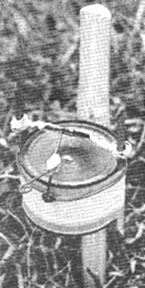 |
FEEWD - This is the new Field Expedient Early Warning Device, a trip wire-activated, rubber band-driven reusable noise maker (Photo by SP4 Rich Fitzpatrick) |
Bobcats' Cans Can Can Charlies
Thanks to
George Foster, 25th Aviation Bn., for sharing this issue,
Ron Leonard, 25th Aviation Bn., for locating and mailing it,
Kirk Ramsey, 2nd Bn., 14th Inf. for creating this page.
This page last modified 8-12-2004
©2004 25th Infantry Division Association. All rights reserved.